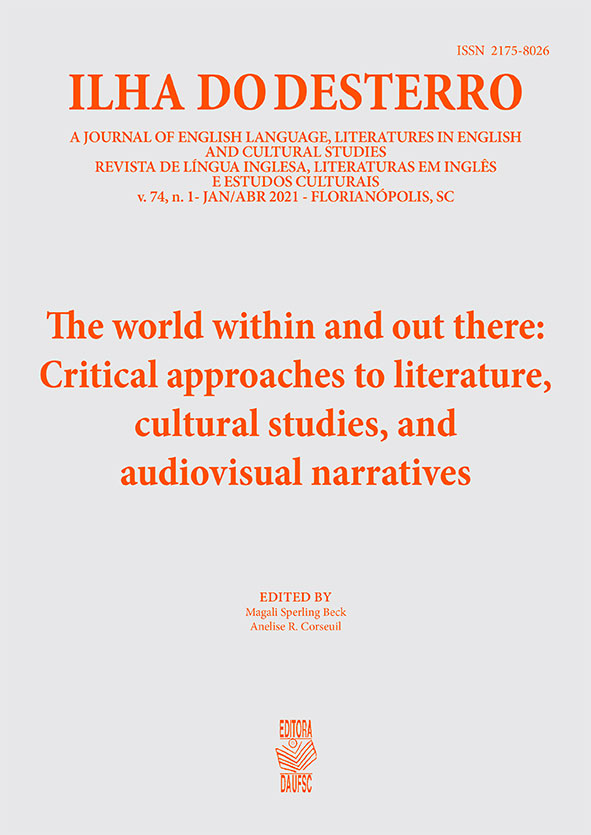Escrita fetichizada nas adaptações para o cinema dos romances The English Patient e Atonement
DOI:
https://doi.org/10.5007/2175-8026.2021.e75946Resumo
Ler e escrever são elementos centrais em The English Patient, romance de Michael Ondaatje (1992), filme de Anthony Minghella (1996); e Atonement, romance de Ian McEwan (2001), filme de Joe Wright (2007). Traçando semelhanças entre essas duas adaptações para o cinema (Hutcheon 2013; Elleström 2017), o presente texto ilustra como palavras escritas e objetos relacionados à escrita podem ser fetichizados cinematograficamente (Apter 1991; Mulvey 1996); e sugere por que, apesar de serem capazes de existir como criações autônomas, ambos os filmes mantêm orgulhosamente uma conexão estreita com seus romances originais, constituindo-se assim como duplas propositadas.
Referências
Apter, Emily. Feminizing the Fetish: Psychoanalysis and Narrative Obsession in Turn-of-the-Century France. Cornell University Press, 1991.
Atonement. Directed by Joe Wright, performances by Saoirse Ronan, Keira Knightley, James McAvoy, and Romola Garai, Universal Pictures, 2007.
Bolland, John. Michael Ondaatje’s The English Patient: a reader’s guide. Continuum, 2002.
Cahir, Linda Costanzo. Literature into Film: theory and practical approaches. McFarland & Company, 2006.
Bradshaw, Peter. “Atonement.” The Guardian, 7 September 2007. https://www.theguardian.com/film/2007/sep/07/romance.keiraknightley. Accessed 10 June 2020.
Ebert, Roger. “The English Patient.” RogerEbert.com, 22 November 1996, https://www.rogerebert.com/reviews/the-english-patient-1996. Accessed 12 June 2020.
Ellam, Julie. Ian McEwan’s Atonement: a reader’s guide. Continuum, 2009.
Elleström, Lars. “Adaptation and intermediality.” The Oxford Handbook of Adaptation Studies, edited by Thomas Leitch. Oxford University Press, 2017. pp. 509-526.
Elley, Derek. “Atonement.” Variety, 29 Aug. 2007,
https://variety.com/2007/film/awards/atonement-6-1200556868/. Accessed 12 June 2020.
Elliott, Kamilla. “Novels, films, and the word/image wars.” A companion to literature and film, edited by Robert Stam and Alessandra Raengo. Blackwell, 2004. pp. 1-22.
Ellis, John. The Literary Adaptation, Screen, v. 23, n. 1, May/June 1982, pp. 3-5.
Fischer, Lucy. Body Double: the author incarnate in the cinema. Rutgers University Press, 2013.
Freud, Sigmund. Sexuality and the Psychology of Love. Simon & Schuster, 1997, pp. 204-209.
Genette, Gérard. Narrative discourse: an essay in method. Translated by Jane E. Lewin. Cornell University Press, 1983.
Geraghty, Christine. “Foregrounding the media: Atonement (2007) as an adaptation.” A Companion to Literature, Film, and Adaptation, edited by Deborah Cartmell. Wiley-Blackwell, 2012. pp. 359-373.
Gleiberman, Owen. “‘The English Patient’: EW review.” Entertainment, 22 November 1996. https://ew.com/article/1996/11/22/movie-review-english-patient/. Accessed 13 June 2020.
Hallet, Wolfgang. “Epistolary forms as semiotic and generic modes in the multimodal novel.” The Epistolary Renaissance: a critical approach to contemporary letter narratives in Anglophone fiction, edited by Maria Löschnigg and Rebekka Schuh. De Gruyter, 2018. p. 125-142.
Herman, David. Narratologies: New Perspectives on Narrative Analysis. Ohio State University Press, 1999.
Hutcheon, Linda [with Siobhan O’Flynn]. A Theory of Adaptation. Second Edition. Routledge, 2013. eBook.
Jost, François. “The look: from film to novel – an essay in comparative narratology”. A Companion to Literature and Film, edited by Robert Stam and Alessandra Raengo. Blackwell, 2004. pp. 71-80
Kozloff, Sarah. Invisible Storytellers: Voice-Over Narration in American Fiction film. University of California Press, 1988.
Laing, Heather. Gabriel Yasred’s The English Patient: a film score guide. Scarecrow Press, 2007.
McEwan, Ian. Atonement. Doubleday, 2002.
Mulvey, Laura. Fetishism and Curiosity. Indiana University Press, 1996.
Ondaatje, Michael. The English Patient. Bloomsbury, 2004.
Noble, William. Show Don’t Tell: a writer’s guide. The Write Thought, 1991.
Shohat, Ella. “Sacred word, profane image: theologies of adaptation.” A Companion to Literature and Film, edited by Robert Stam and Alessandra Raengo. Blackwell, 2004. pp. 23-44.
Schuh, Rebekka. Enveloped in epistolary illusion: the aesthetics of reading and writing letters in selected short stories by Alice Munro. The Epistolary Renaissance: a critical approach to contemporary letter narratives in Anglophone fiction, edited by Maria Löschnigg and Rebekka Schuh. De Gruyter, 2018. p. 73-90.
Simon, Jeff. Not well “The English Patient” suffers from some fatal flaws. The Buffalo News, 22 November 1996. https://buffalonews.com/1996/11/21/not-well-the-english-patient-suffers-from-some-fatal-flaws/. Accessed 14 June 2020.
Somigli, Luca. “The Superhero with a Thousand Faces: Visual Narratives on Film and Paper”. Play It Again, Sam: retakes and remakes, edited by Andrew Horton and Stuart Y. McDougal. University of California Press, 1998. pp. 279-294.
The English Patient. Directed by Anthony Minghella, performances by Juliette Binoche, Ralph Fiennes, and Kristin Scott-Thomas, Miramax, 1996.
Tollance, Pascale. “‘To everyone’, ‘To whom it may concern’: the letter for which no one can answer in Atonement (Ian McEwan and Joe Wright). Études britanniques contemporaines, 55, 2018, https://journals.openedition.org/ebc/5529. Accessed 12 June 2020.
Thomas, Brownen. “‘Piecing together a mirage:’ adapting The English Patient for the screen.” From Page to Screen: Adaptations of the Classic Novel, edited by Robert Giddings and Erica Sheen. Manchester University Press, 2000. pp. 197-232.
Travers, Peter. “Atonement.” Rolling Stone, 14 December 2007. https://www.rollingstone.com/movies/movie-reviews/atonement-252218/. Accessed 11 June 2020.
Walsh, Susie. “Friendly fire: epistolary voice-over in Terrence Malick's ‘The Thin Red Line’.” Literature/Film Quarterly 33, n. 4, 2005, pp. 306-12.
Whelehan, Imelda. “Adaptations: the contemporary dilemmas.” Adaptation: From Text to Screen, Screen to Text, edited by Deborah Cartmell and Imelda Whelehan. Routledge, 2005, pp. 3-19.
Wootton, Sarah. “‘Here then is a maze to begin, be in’: Michael Ondaatje’s Byronic Inheritance.” Romantic Presences in the Twentieth Century, edited by Mark Sandy. Routledge, 2016. pp. 163-174.
Downloads
Publicado
Edição
Seção
Licença
Copyright (c) 2020 Cynthia Beatrice Costa

Este trabalho está licenciado sob uma licença Creative Commons Attribution 4.0 International License.
A revista Ilha do Desterro publica artigos e resenhas inéditos, referentes as áreas de Inglês, Literaturas em Língua Inglesa e Estudos Culturais. Publica volumes mistos e/ou temáticos, com artigos e resenhas em inglês e português.
Autores mantém os direitos autorais e concedem à revista o direito de primeira publicação, com o trabalho simultaneamente licenciado sob a Licença Creative Commons Attribution que permite o compartilhamento do trabalho com reconhecimento da autoria e publicação inicial nesta revista.

This work is licensed under a Creative Commons Attribution 4.0 International License.



